
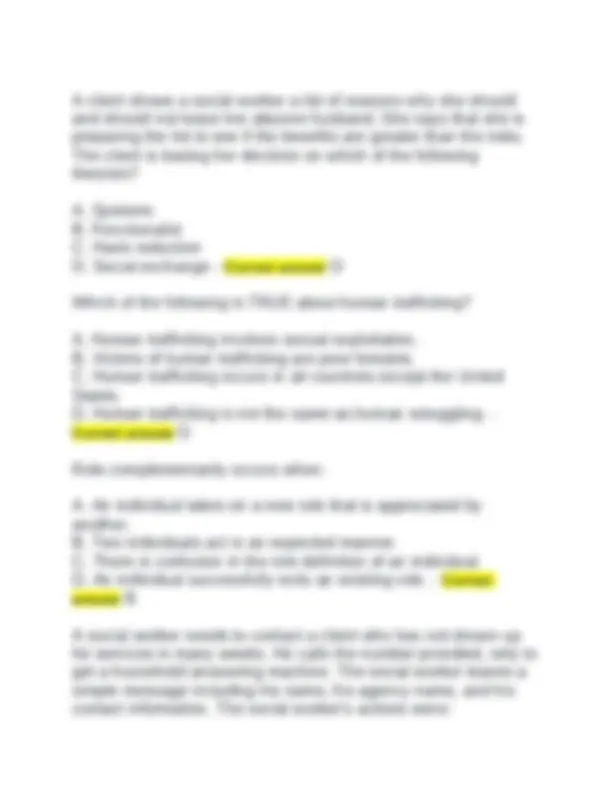
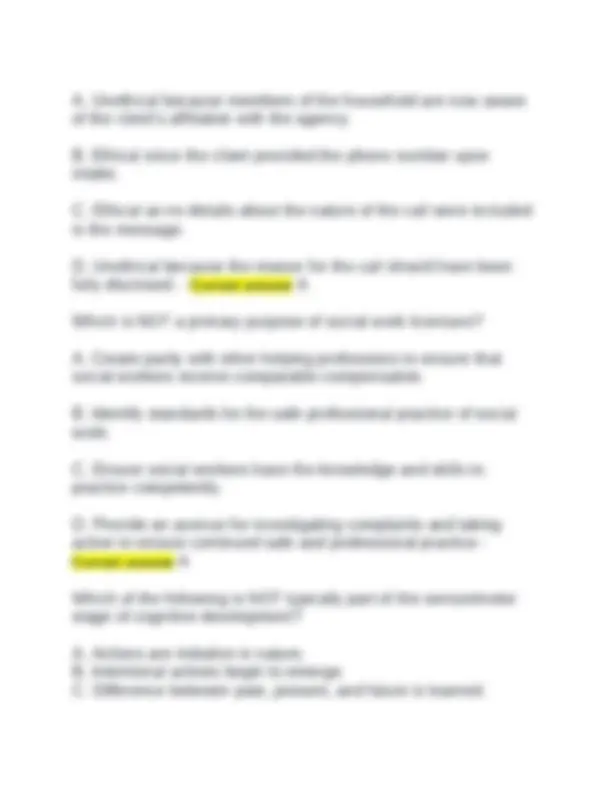
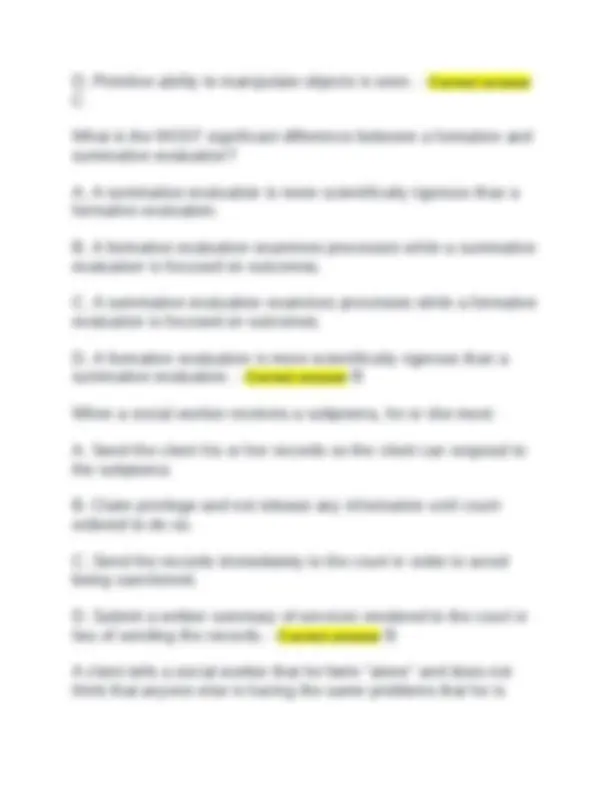
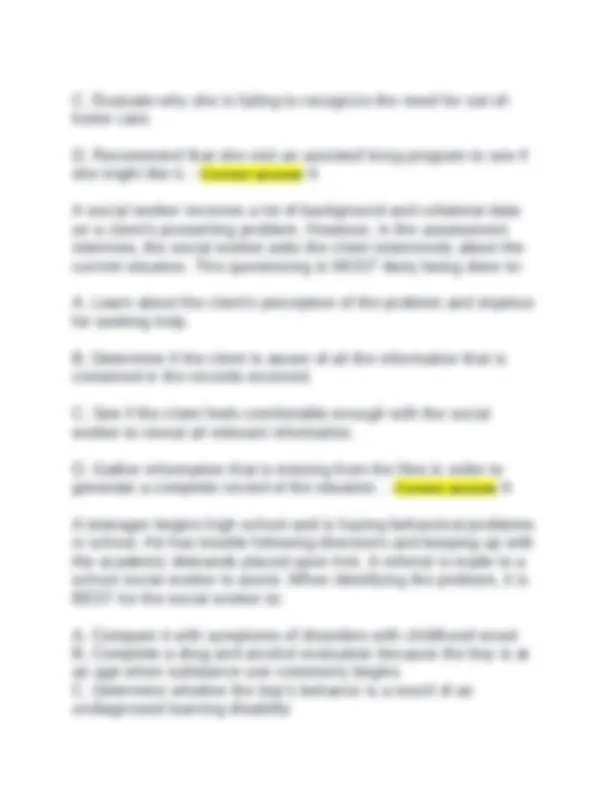
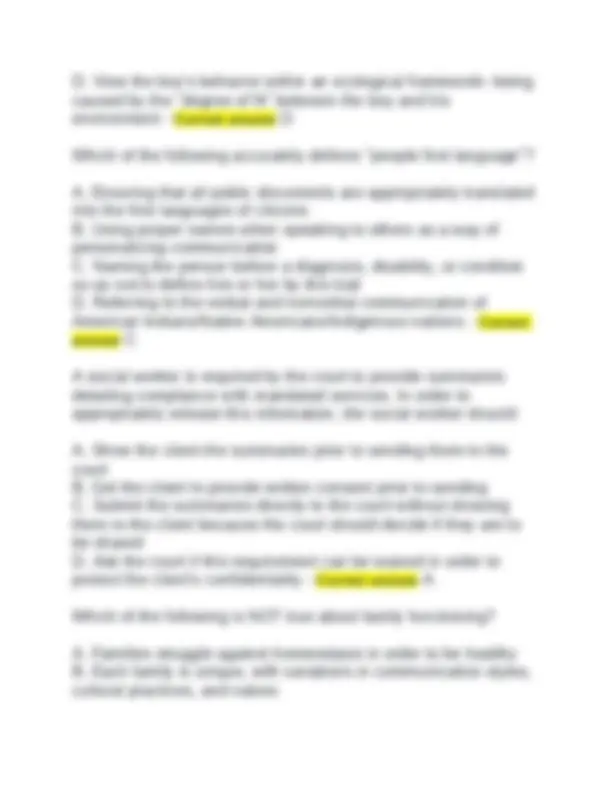
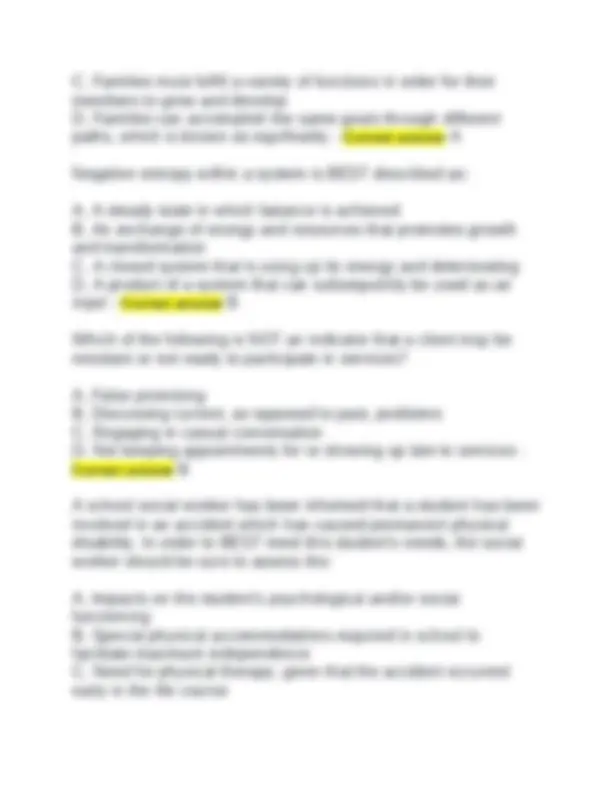
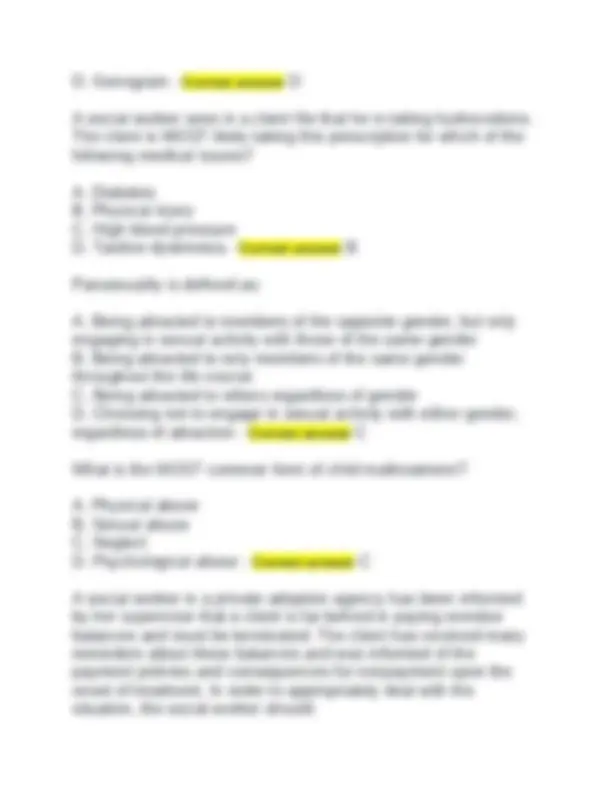
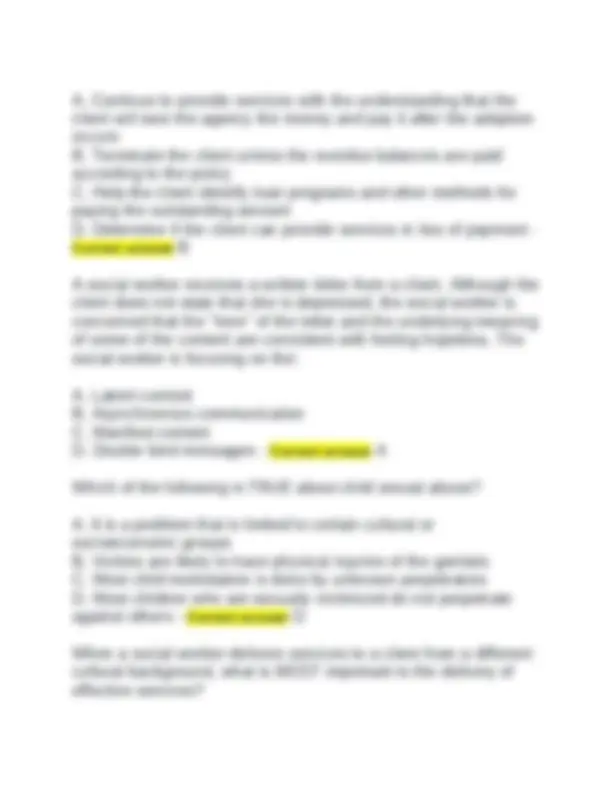
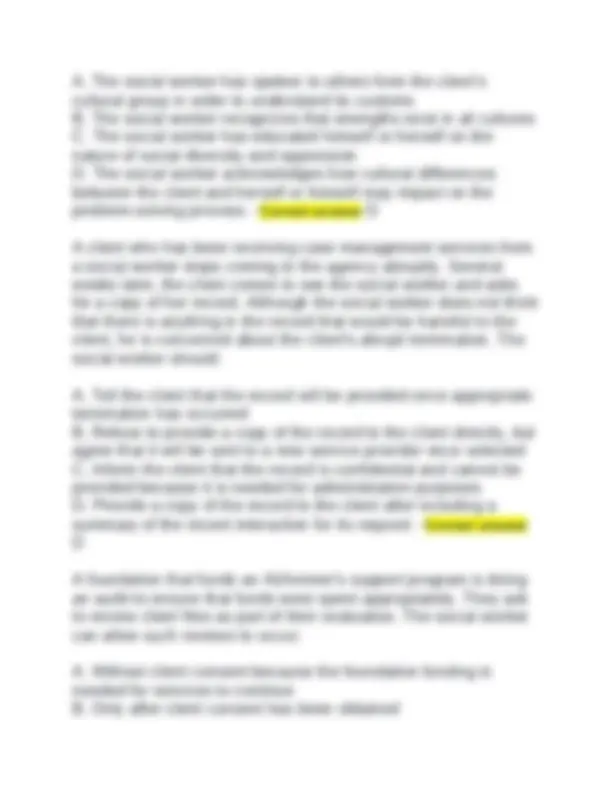
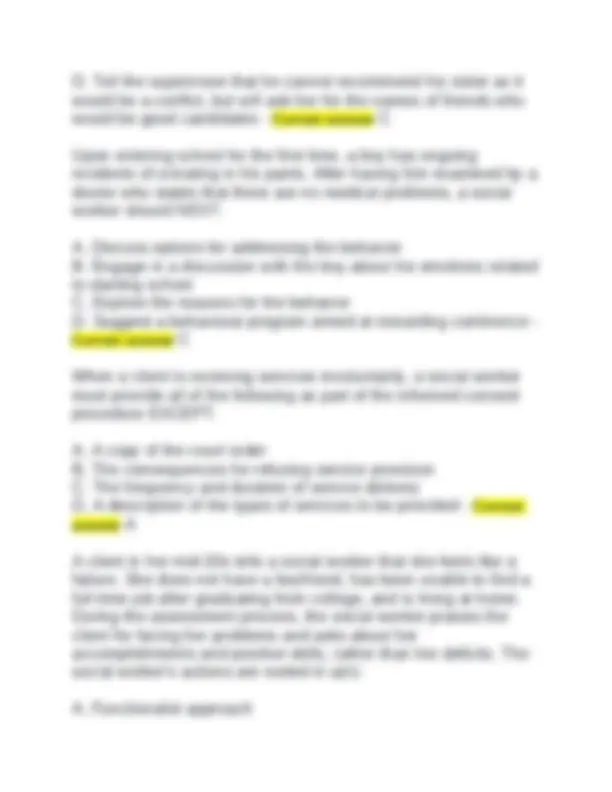
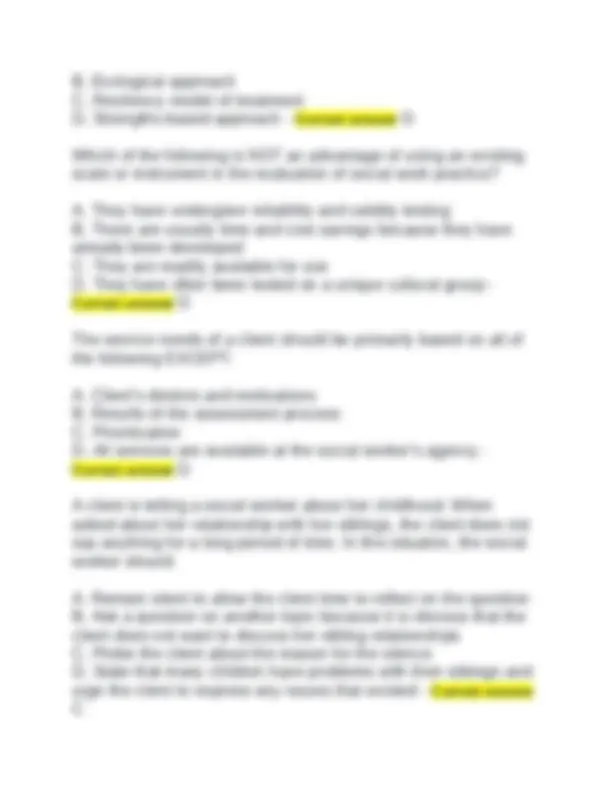
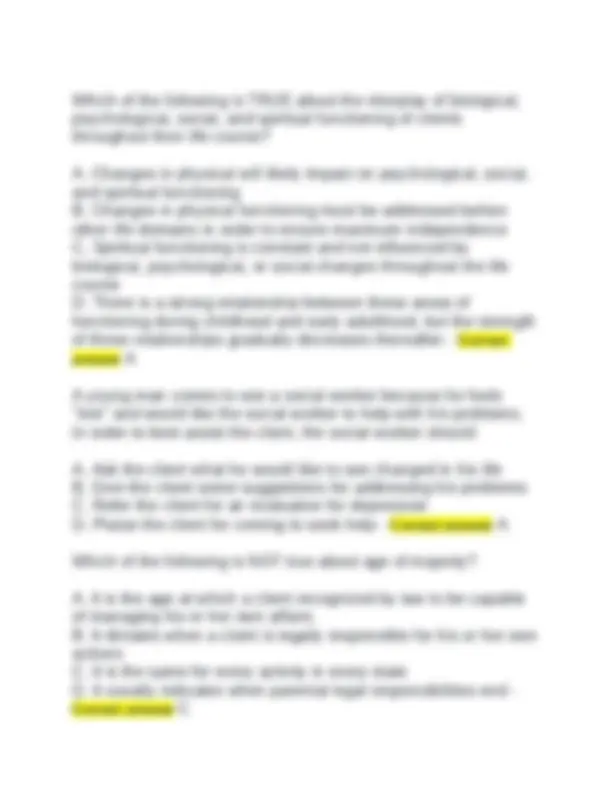
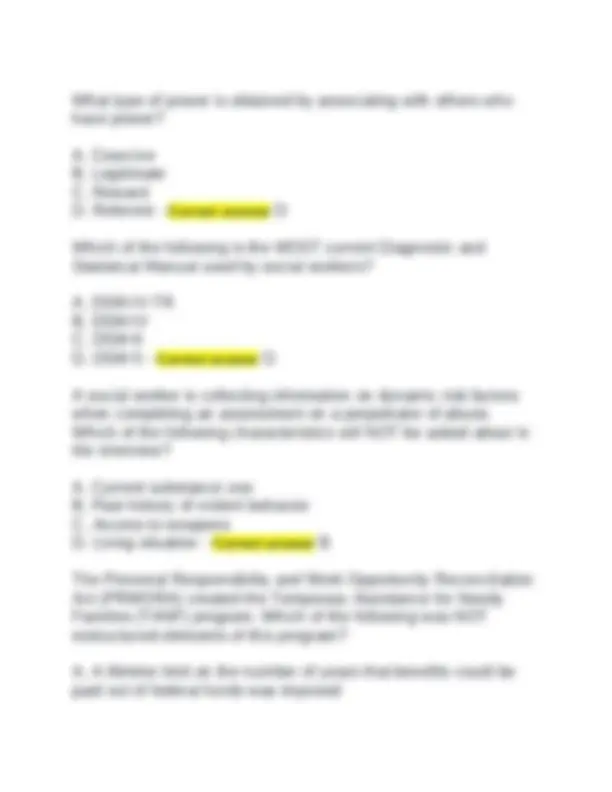
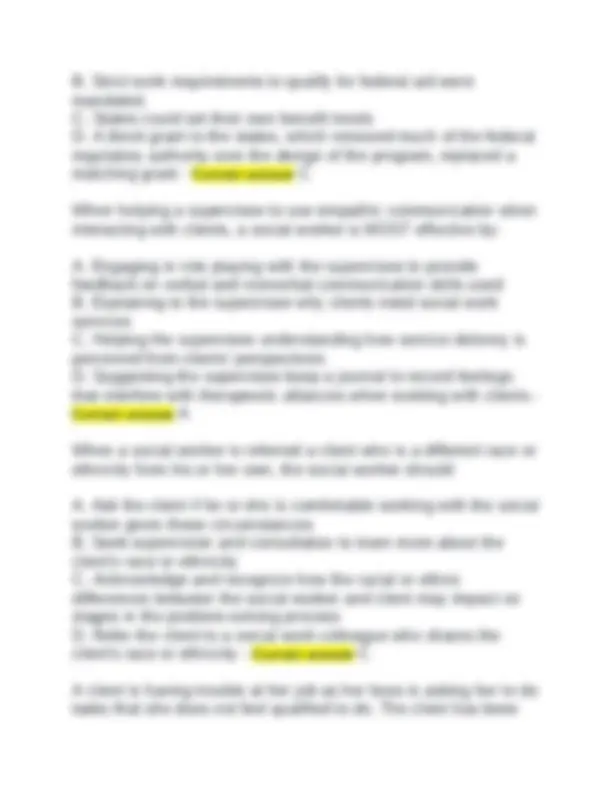
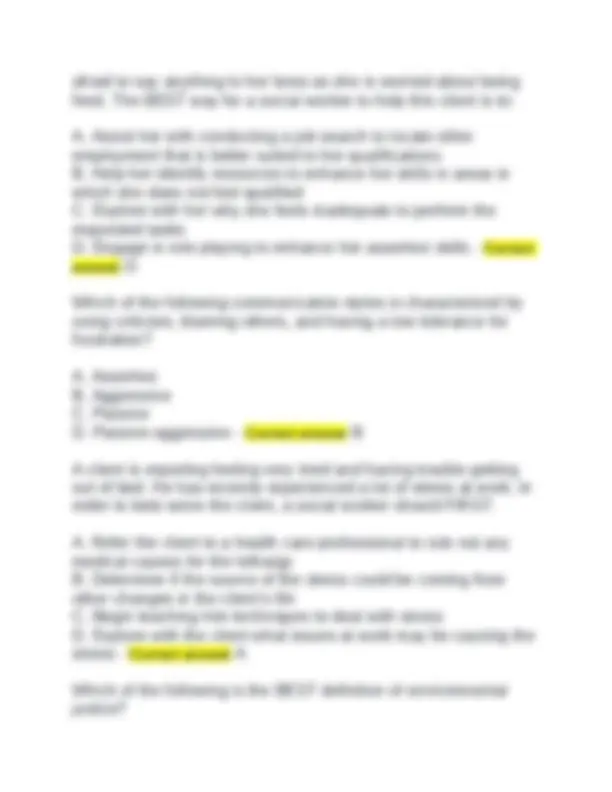
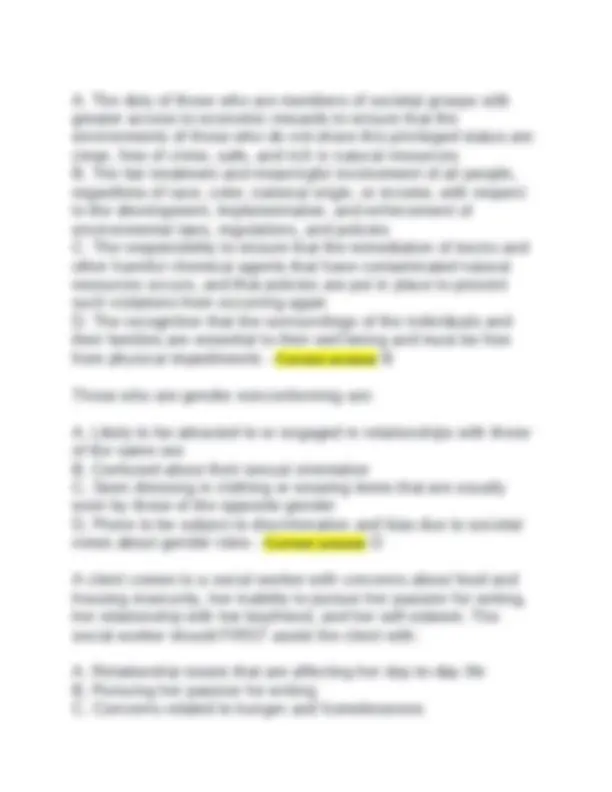
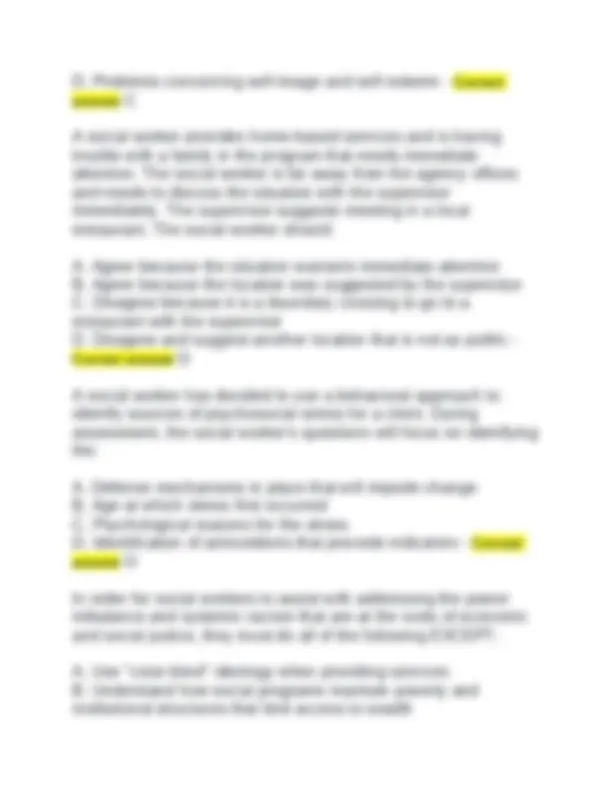

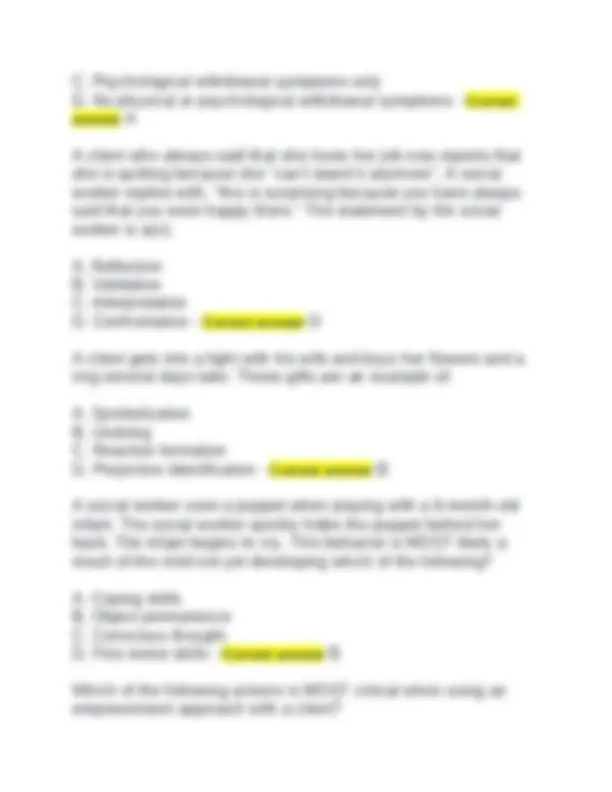
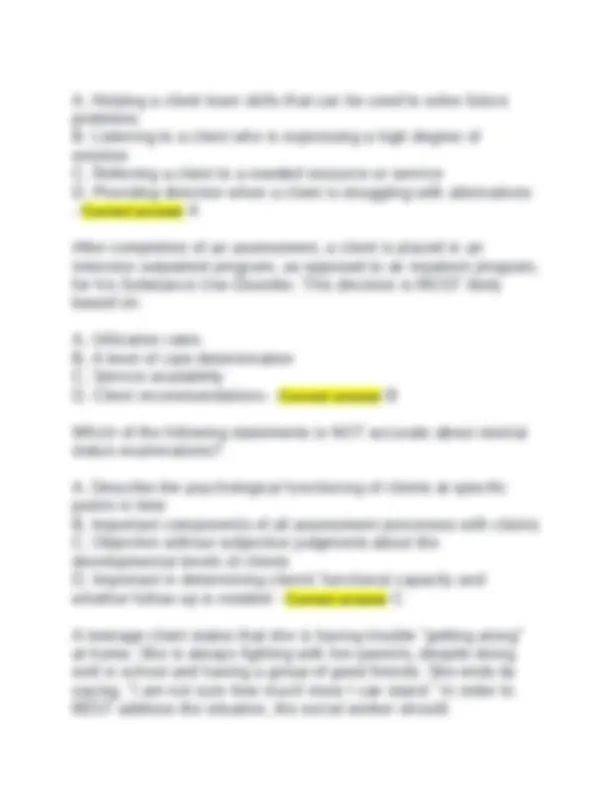
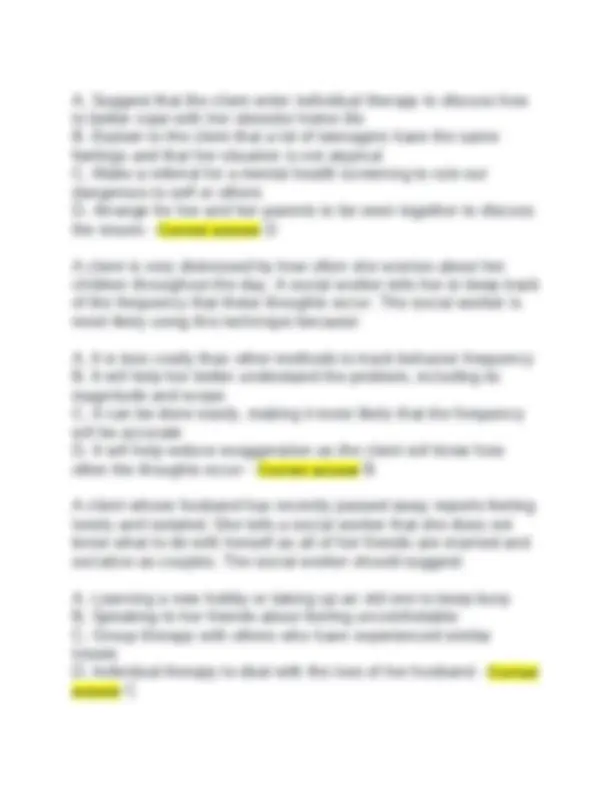
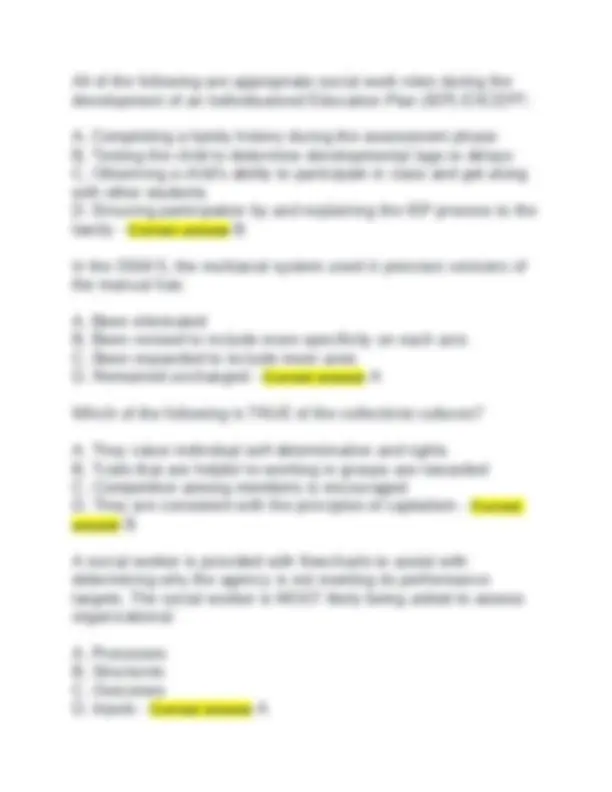
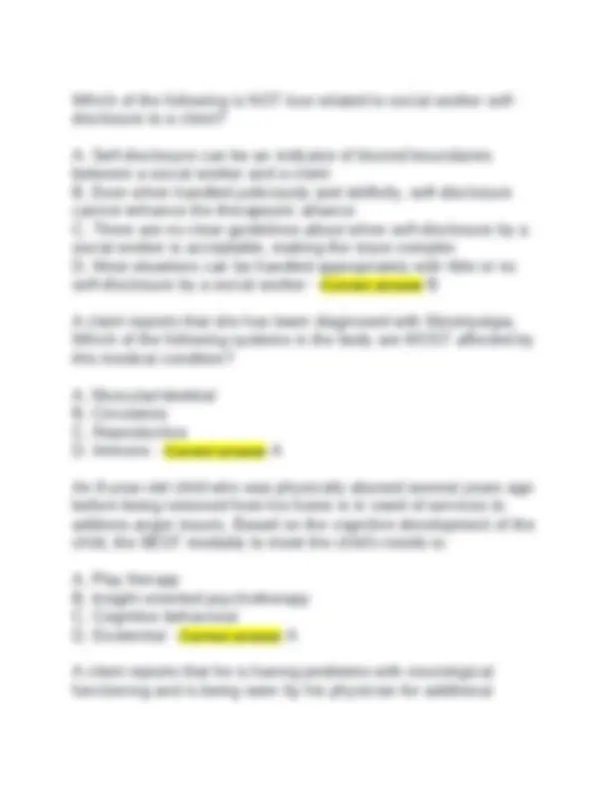
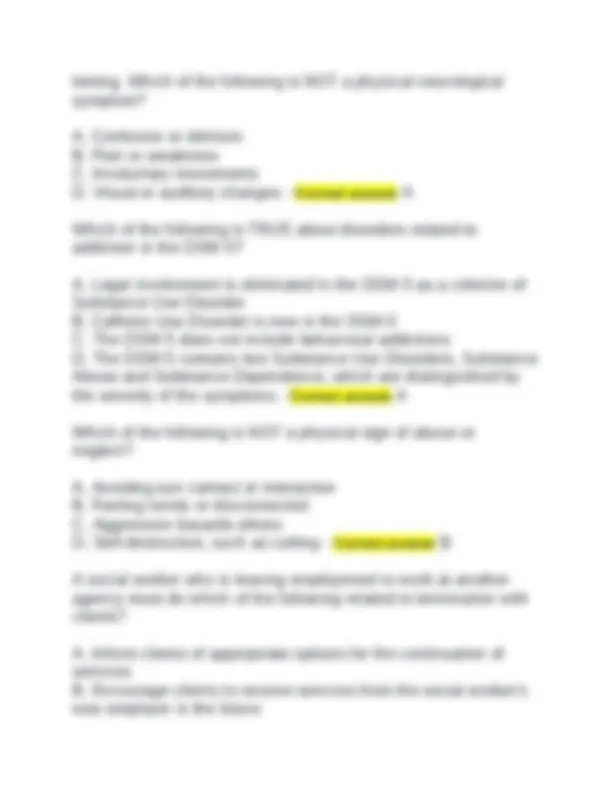
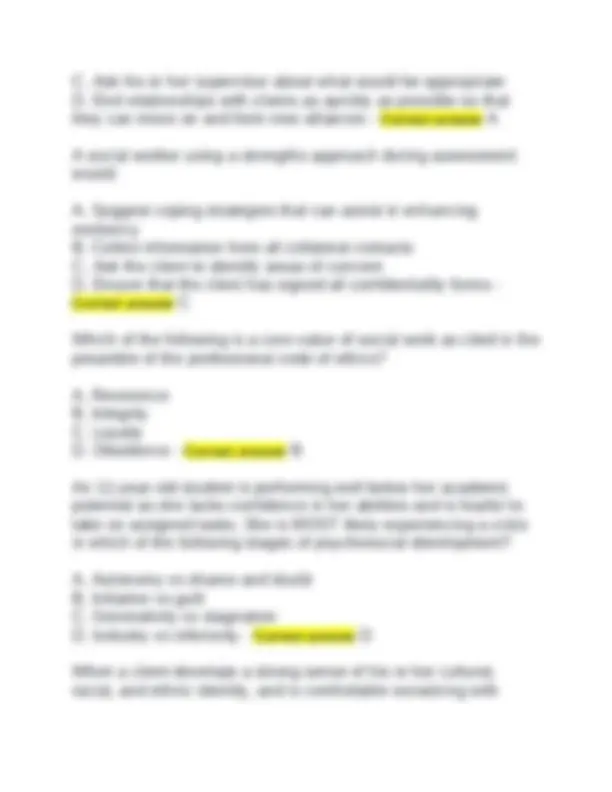
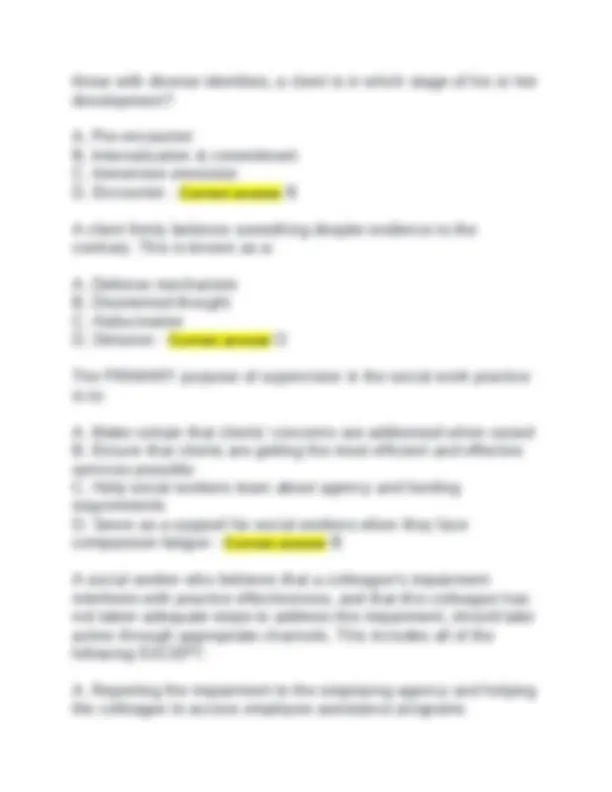
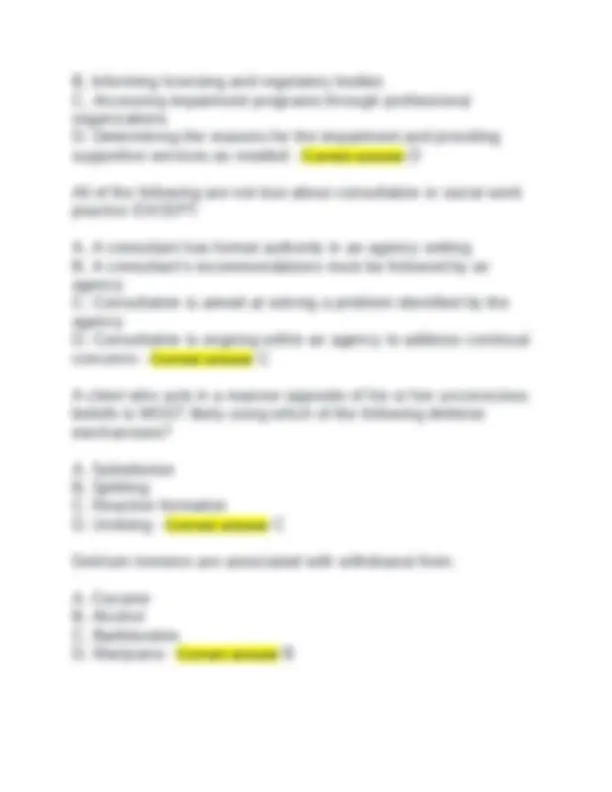
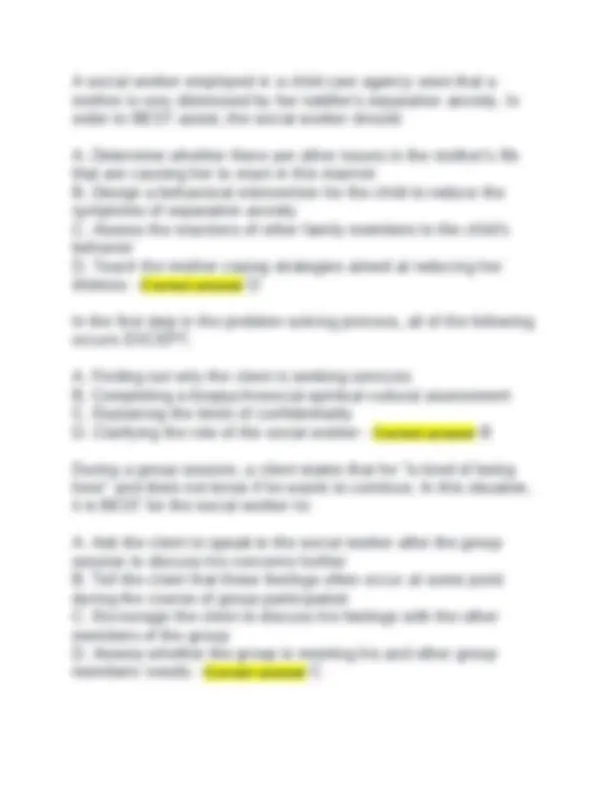
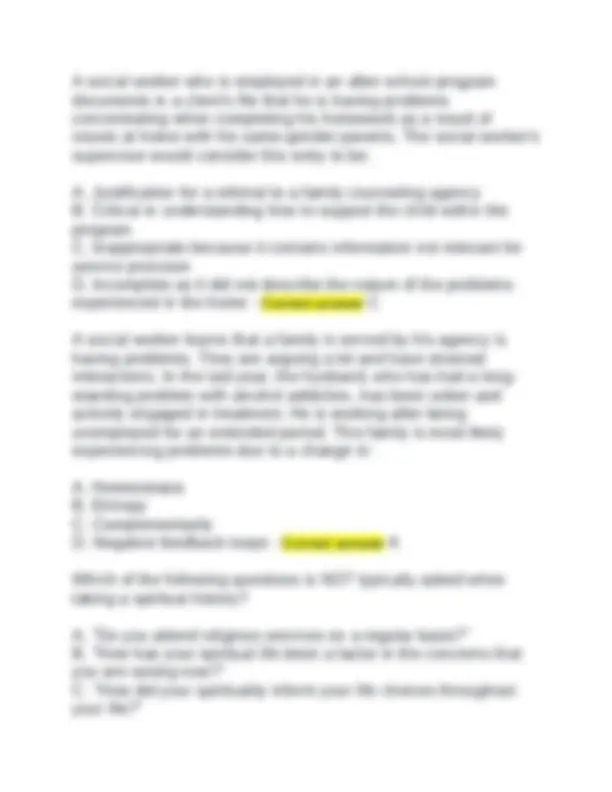
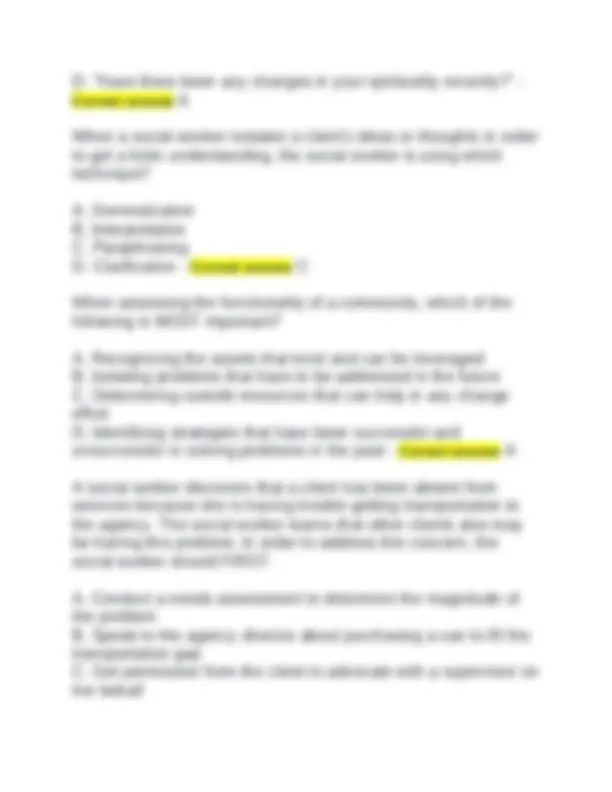
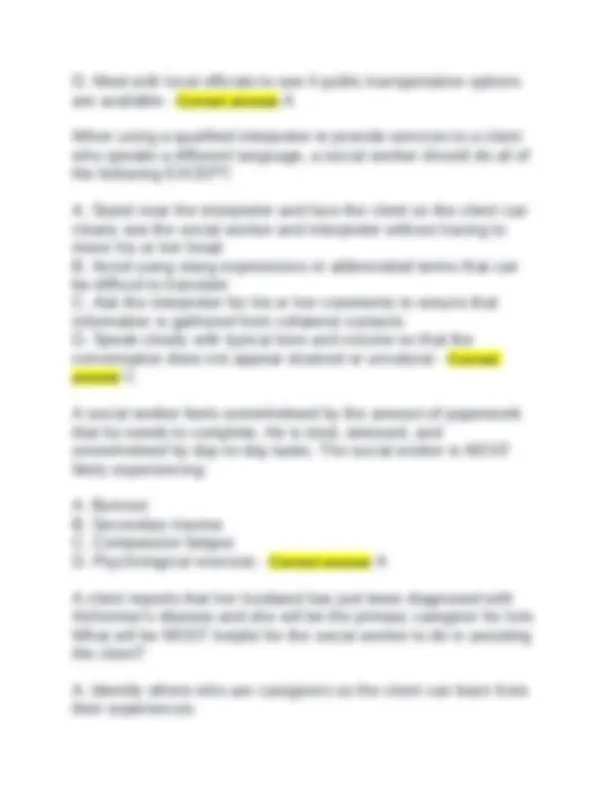
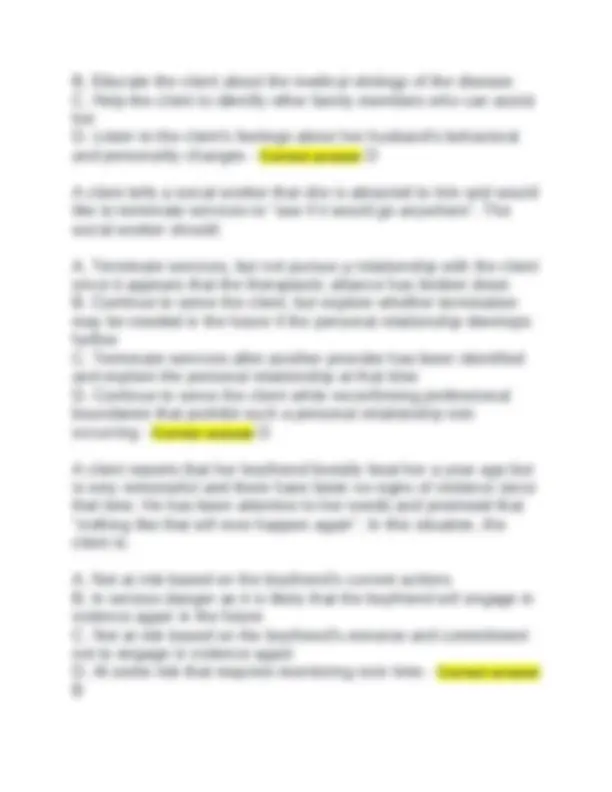
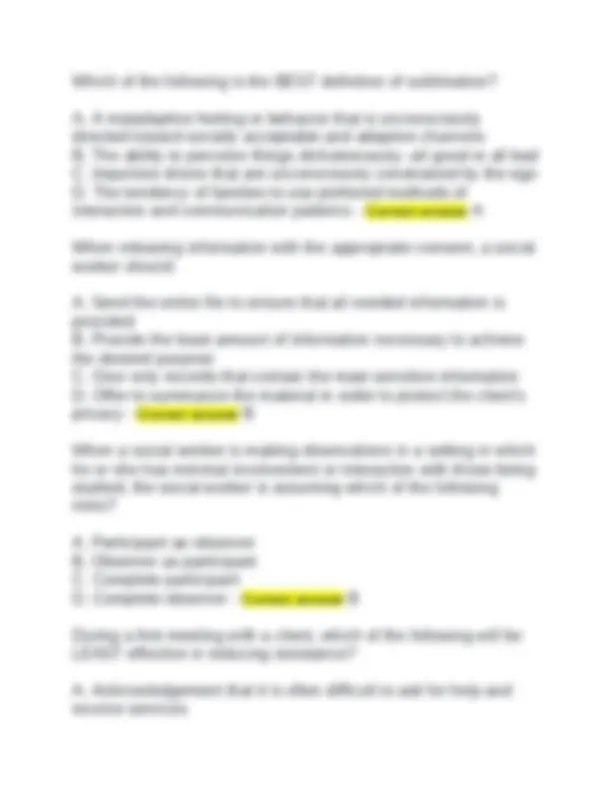
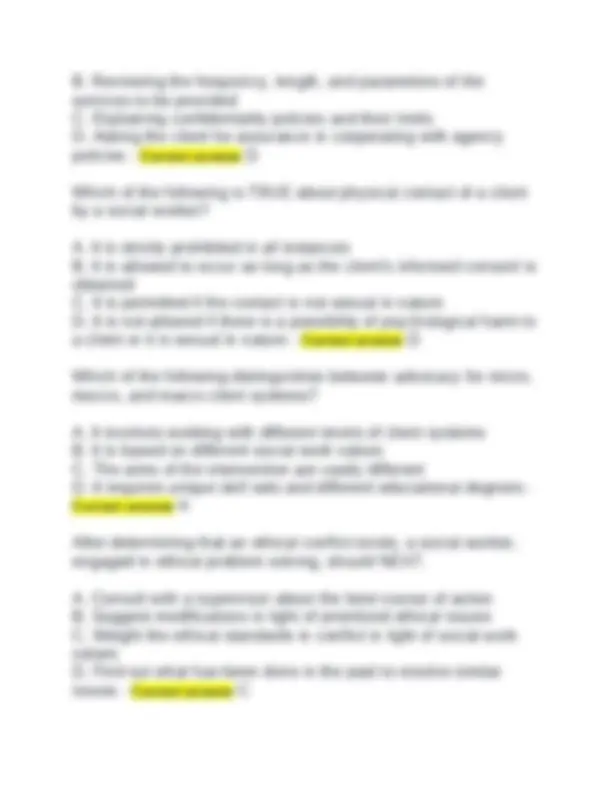
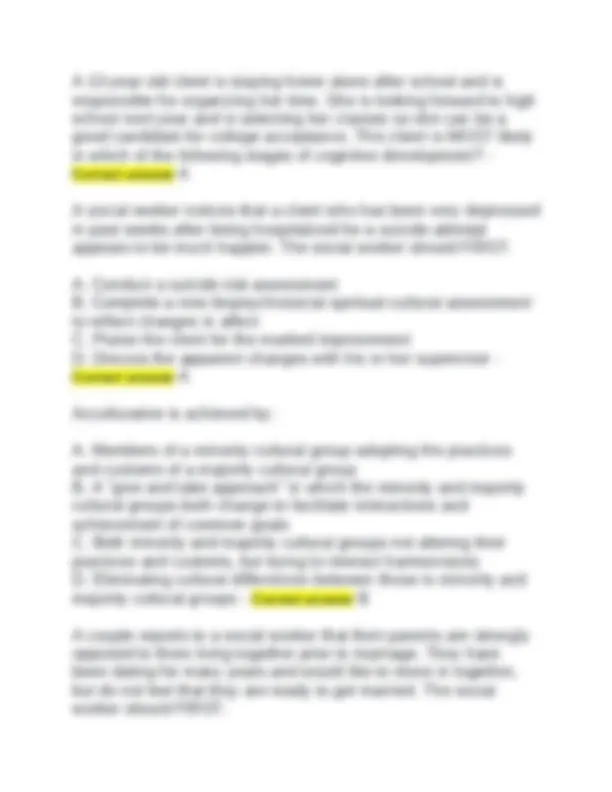
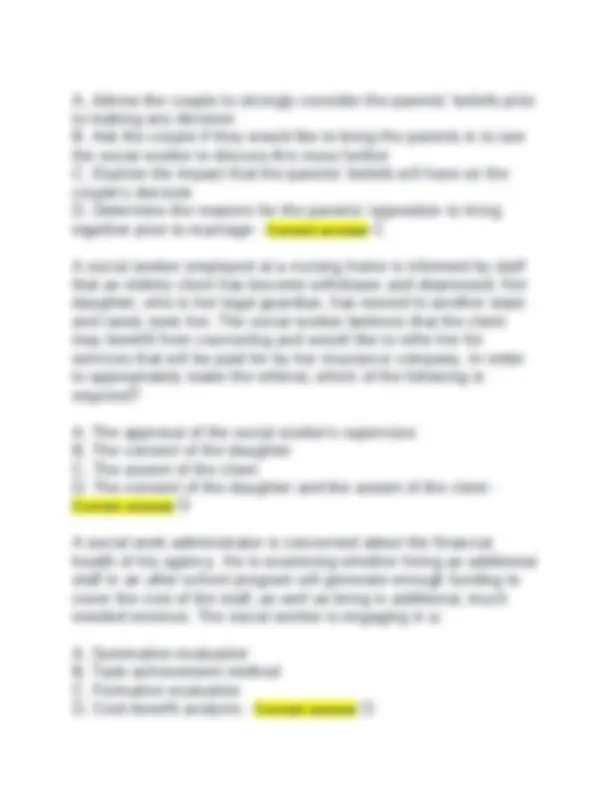
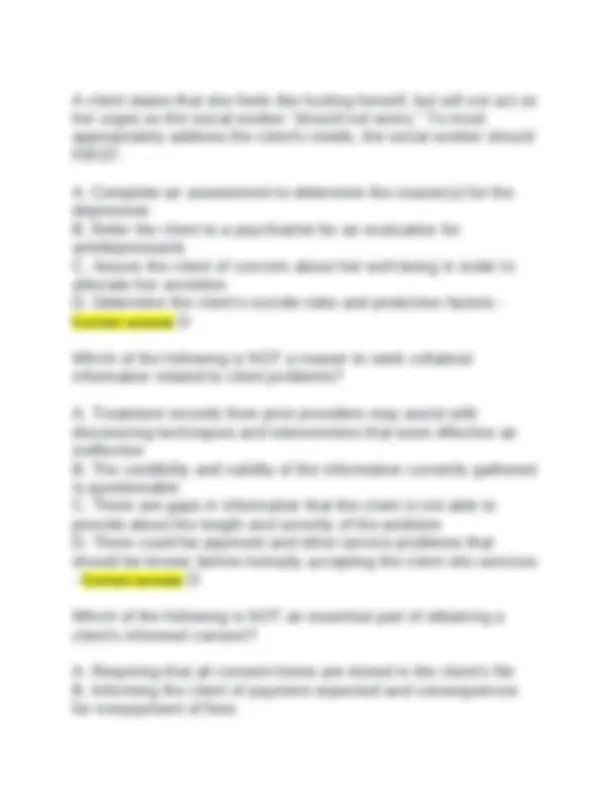
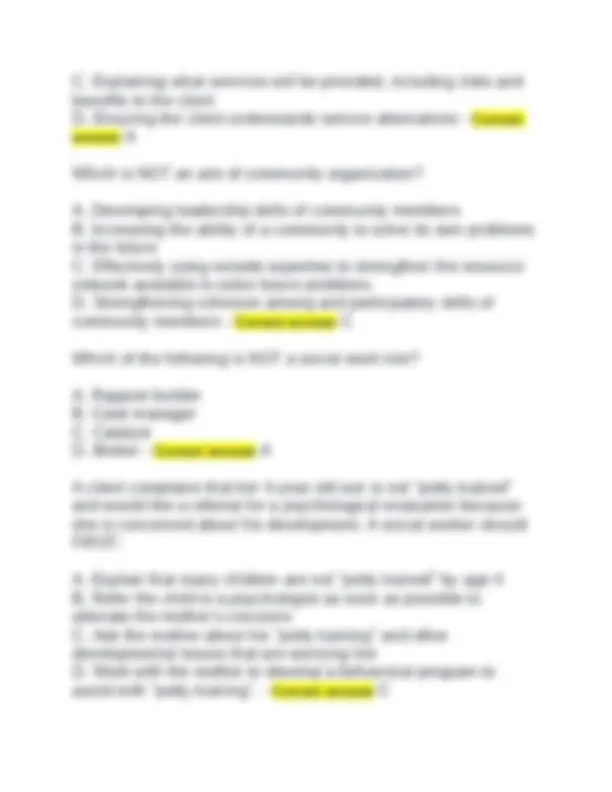
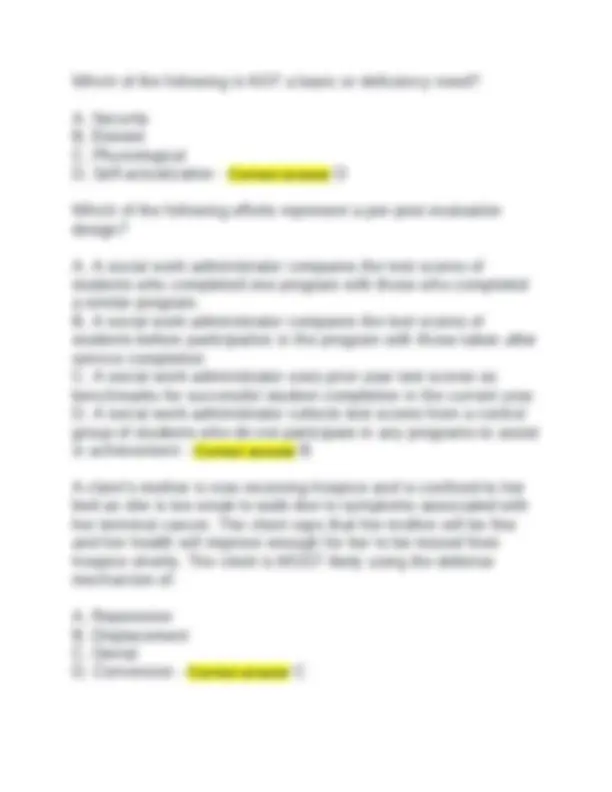
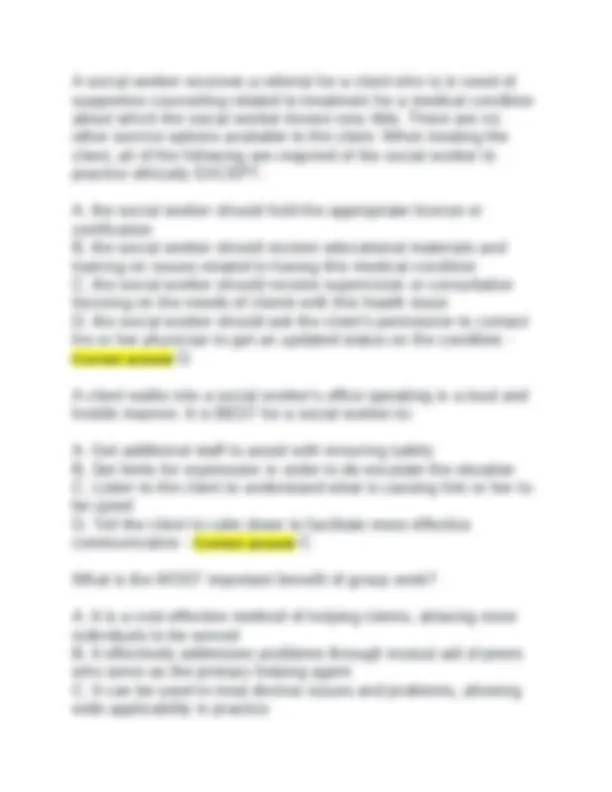
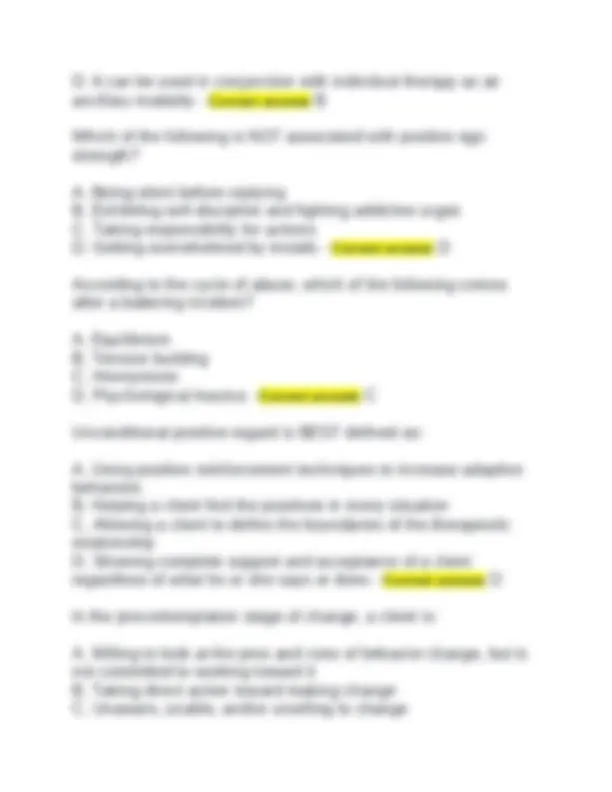
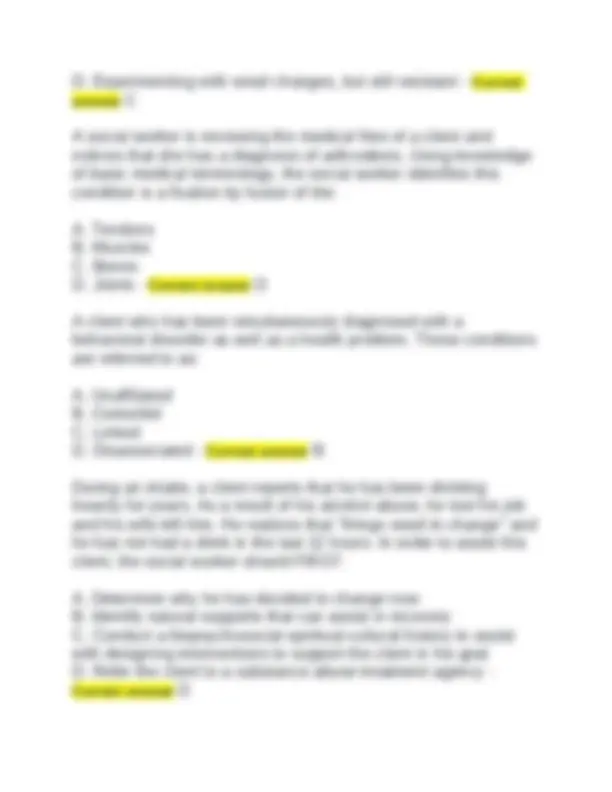
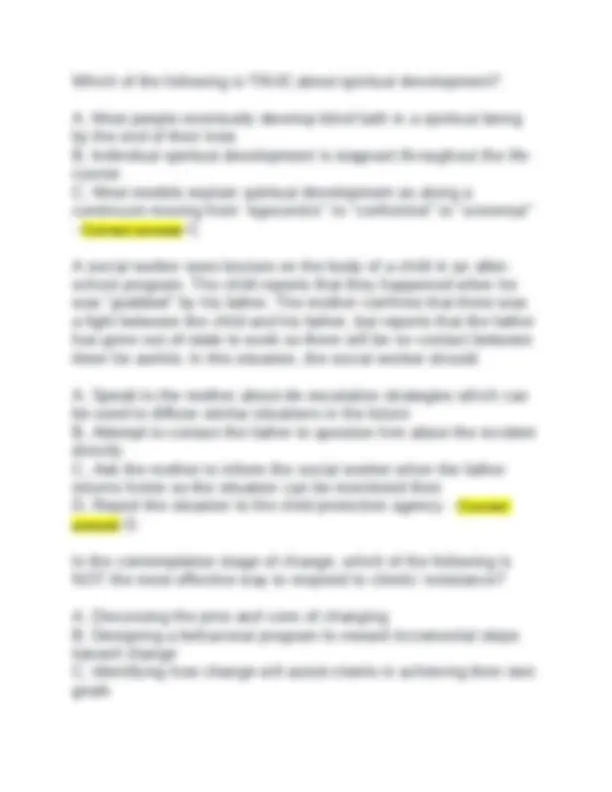
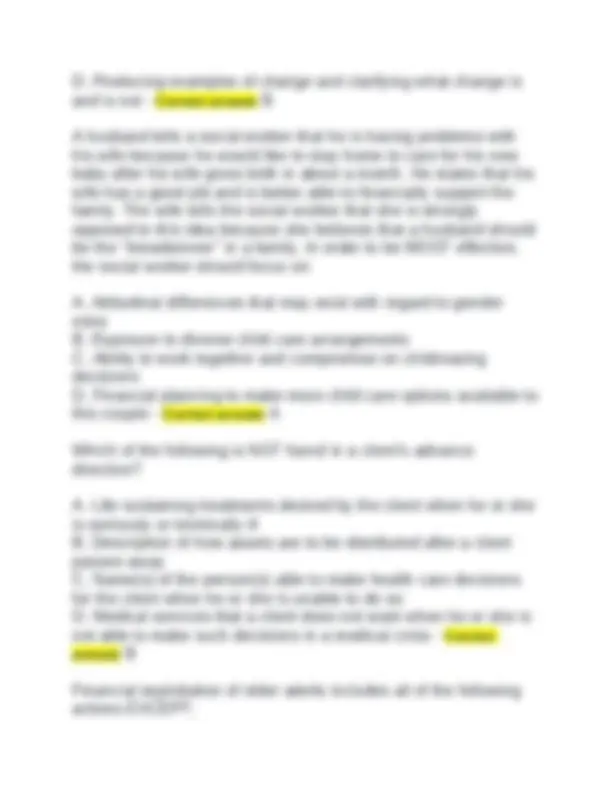
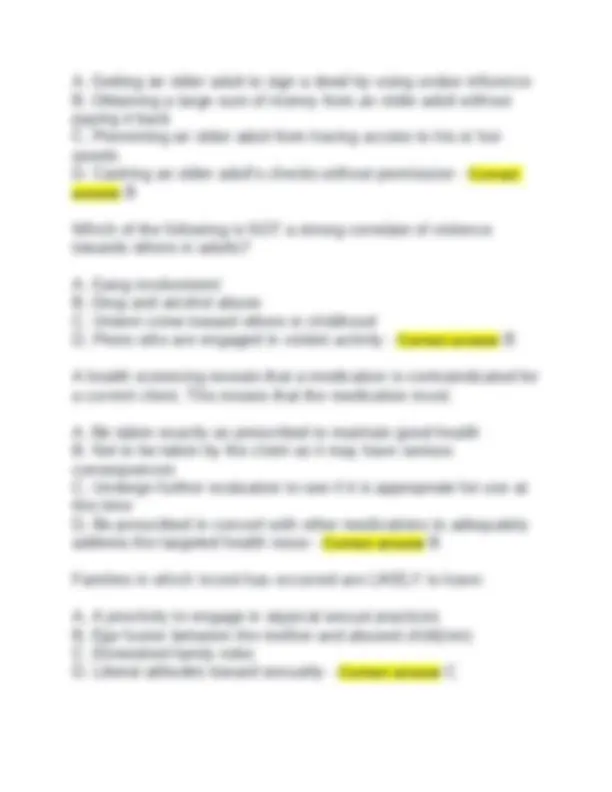
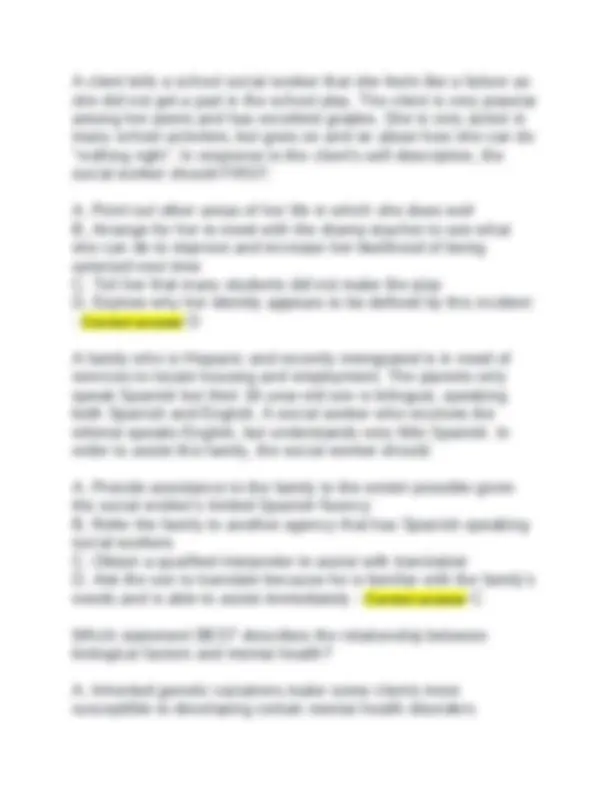
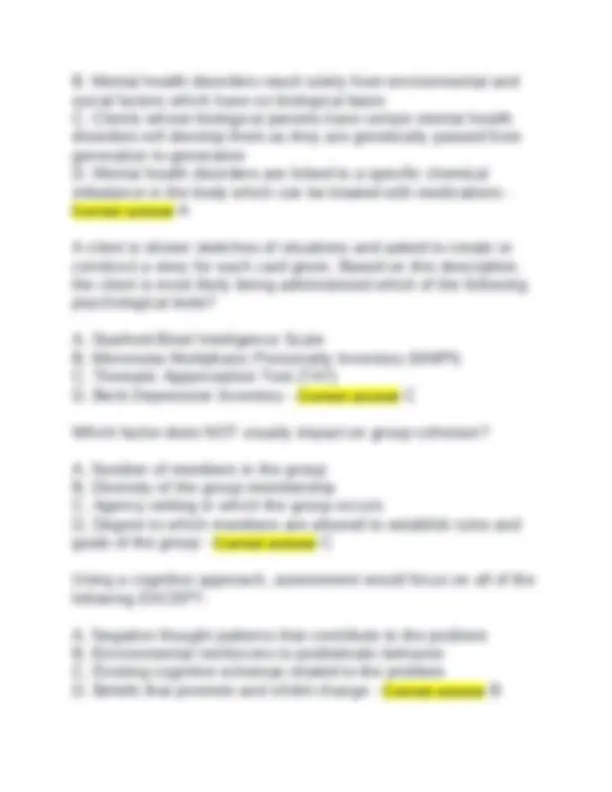
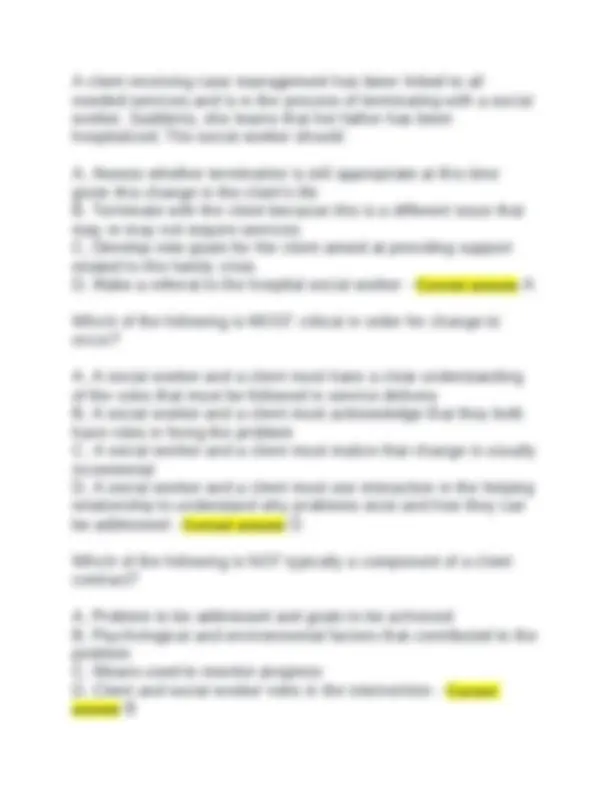
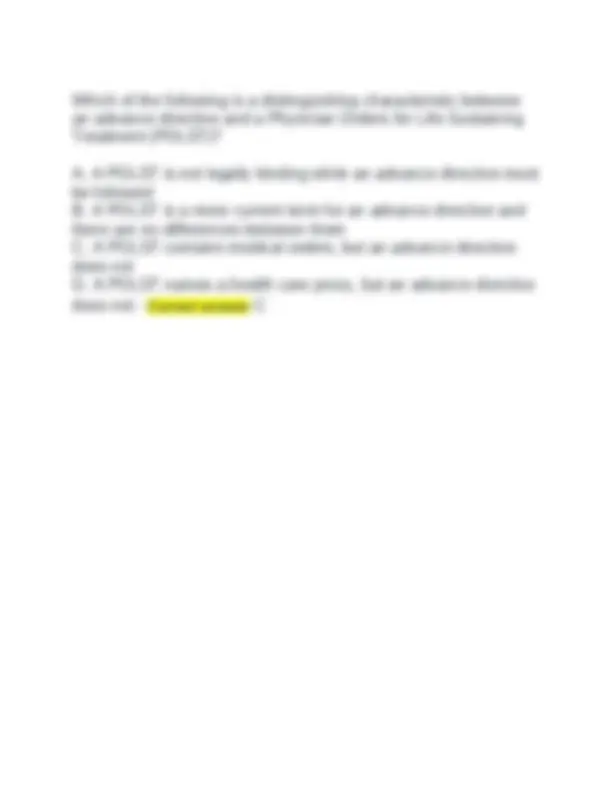


Study with the several resources on Docsity

Earn points by helping other students or get them with a premium plan


Prepare for your exams
Study with the several resources on Docsity

Earn points to download
Earn points by helping other students or get them with a premium plan
Community
Ask the community for help and clear up your study doubts
Discover the best universities in your country according to Docsity users
Free resources
Download our free guides on studying techniques, anxiety management strategies, and thesis advice from Docsity tutors
ASWB Practice Exam Questions and Answers.ASWB Practice Exam Questions and Answers.
Typology: Exams
1 / 57

This page cannot be seen from the preview
Don't miss anything!


















































Social workers should refer clients to other professionals in all of the following instances EXCEPT when: A. Professionals' specialized knowledge or expertise is needed to meet the clients' needs. B. Social workers believe they are not being effective in addressing clients' concerns. C. Professionals believe that other modalities of treatment may be more effective to resolve clients' issues. D. Social workers are not making reasonable progress in addressing clients' problems. - Correct answer C A social worker is working with a second grade child who is having trouble staying in her seat in the classroom. The social worker, in conjunction with the teacher, indicates that the immediate objective is that the child "will remain seated after being reminded to do so by the teacher while in the classroom." The social worker's supervisor, after reviewing the objective, would judge it to be: A. Adequate as it addresses the target problem B. Inadequate as it puts too much responsibility on the teacher C. Adequate since the teacher was involved in the process D. Inadequate as it lacks some elements of a measurable objective - Correct answer D A social worker may limit a client's self-determination when the clients' actions: A. Pose a serious and imminent risk to self or others according to the social worker's judgment.
B. Cause significant family dysfunction which threatens to impact on the psychological well-being of its members. C. Result in legal action such as arrests, fines, and/or civil penalties. D. Violate agency procedures and policies as established by the chief executive officer - Correct answer A During assessment, partialization can be used by a social worker to assist a client with all of the following EXCEPT: A. Recognizing the next action to take when intervening in a situation B. Helping to clarify the specific cause(s) of a problem C. Identifying issues that need immediate attention D. Distinguishing areas that require further inquiry - Correct answer A According to Erikson, which of the following is seen as the last stage in psychosocial development? A. Ego integrity v. Despair B. Trust v. Mistrust C. Intimacy v. Isolation D. Autonomy v. Shame and doubt - Correct answer A Psychological abuse is MOST often detected by: A. Confessions of perpetrators B. Information supplied by collateral contacts C. Behavioral characteristics of victims D. Bruises or marks left by comorbid physical mistreatment - Correct answer C
A. Unethical because members of the household are now aware of the client's affiliation with the agency. B. Ethical since the client provided the phone number upon intake. C. Ethical as no details about the nature of the call were included in the message. D. Unethical because the reason for the call should have been fully disclosed. - Correct answer A Which is NOT a primary purpose of social work licensure? A. Create parity with other helping professions to ensure that social workers receive comparable compensation. B. Identify standards for the safe professional practice of social work. C. Ensure social workers have the knowledge and skills to practice competently. D. Provide an avenue for investigating complaints and taking action to ensure continued safe and professional practice - Correct answer A Which of the following is NOT typically part of the sensorimotor stage of cognitive development? A. Actions are imitative in nature. B. Intentional actions begin to emerge. C. Difference between past, present, and future is learned.
D. Primitive ability to manipulate objects is seen. - Correct answer C What is the MOST significant difference between a formative and summative evaluation? A. A summative evaluation is more scientifically rigorous than a formative evaluation. B. A formative evaluation examines processes while a summative evaluation is focused on outcomes. C. A summative evaluation examines processes while a formative evaluation is focused on outcomes. D. A formative evaluation is more scientifically rigorous than a summative evaluation. - Correct answer B When a social worker receives a subpoena, he or she must: A. Send the client his or her records so the client can respond to the subpoena B. Claim privilege and not release any information until court- ordered to do so. C. Send the records immediately to the court in order to avoid being sanctioned. D. Submit a written summary of services rendered to the court in lieu of sending the records. - Correct answer B A client tells a social worker that he feels "alone" and does not think that anyone else is having the same problems that he is
A. Receptive communication skills usually develop at an earlier age than expressive language. B. Play is important to cognitive, social, and physical development. C. Behavioral outbursts can be signs of psychological disturbance. D. Personality or temperament results from both biological and environmental factors. - Correct answer C Which of the following is TRUE about Do Not Resuscitate (DNR) orders? A. They provide legal permission for euthanasia. B. They must be done in conjunction with a durable power of attorney. C. They do not allow any medications to be given. D. They permit clients to refuse mechanical ventilation or artificial hydration. - Correct answer D An elderly client is being discharged from the hospital. She has memory loss and trouble performing activities of daily living, and therefore needs significant support. She would like to return home. In this situation, what should the social worker do FIRST? A. Identify natural and other community supports that can assist her at home. B. Help to develop a long-term plan to meet her increasing care needs.
C. Evaluate why she is failing to recognize the need for out-of- home care. D. Recommend that she visit an assisted living program to see if she might like it. - Correct answer A A social worker receives a lot of background and collateral data on a client's presenting problem. However, in the assessment interview, the social worker asks the client extensively about the current situation. This questioning is MOST likely being done to: A. Learn about the client's perception of the problem and impetus for seeking help. B. Determine if the client is aware of all the information that is contained in the records received. C. See if the client feels comfortable enough with the social worker to reveal all relevant information. D. Gather information that is missing from the files in order to generate a complete record of the situation. - Correct answer A A teenager begins high school and is having behavioral problems in school. He has trouble following directions and keeping up with the academic demands placed upon him. A referral is made to a school social worker to assist. When identifying the problem, it is BEST for the social worker to: A. Compare it with symptoms of disorders with childhood onset B. Complete a drug and alcohol evaluation because the boy is at an age when substance use commonly begins C. Determine whether the boy's behavior is a result of an undiagnosed learning disability
C. Families must fulfill a variety of functions in order for their members to grow and develop D. Families can accomplish the same goals through different paths, which is known as equifinality - Correct answer A Negative entropy within a system is BEST described as: A. A steady state in which balance is achieved B. An exchange of energy and resources that promotes growth and transformation C. A closed system that is using up its energy and deteriorating D. A product of a system that can subsequently be used as an input - Correct answer B Which of the following is NOT an indicator that a client may be resistant or not ready to participate in services? A. False promising B. Discussing current, as opposed to past, problems C. Engaging in casual conversation D. Not keeping appointments for or showing up late to services - Correct answer B A school social worker has been informed that a student has been involved in an accident which has caused permanent physical disability. In order to BEST meet this student's needs, the social worker should be sure to assess the: A. Impacts on the student's psychological and/or social functioning B. Special physical accommodations required in school to facilitate maximum independence C. Need for physical therapy, given that the accident occurred early in the life course
D. Mobility of both the arms and legs, given that physical limitations exist - Correct answer A Which of the following is TRUE about stereotypes? A. Negative stereotypes are harmful when perpetuated, but good stereotypes should be used to highlight strengths about groups of people B. Stereotypes preserve social hierarchies and the interests of dominant groups C. Stereotypes are based on data or factual information D. Stereotypes do not change with the shifting interests and concerns of society - Correct answer B A school social worker learns that a 10-year-old student has just been placed into foster care because physical abuse by her parents has been substantiated. The social worker has had many referrals for this student in recent weeks concerning incidents of bullying other children. This student's behavior is MOST likely a result of: A. Displacement B. Reaction formation C. Projection D. Incorporation - Correct answer A A social worker and her supervisor are meeting when a teenager comes into the office and wants "to talk". The teenager reports that she is "being tortured" at home and is the victim of emotional and physical abuse. The supervisor tells the social worker that this child made similar allegations several years ago and they were not substantiated by the child protection agency. The supervisor tells the social worker to "monitor" the situation and keep the teenager informed if any subsequent allegations are made by the teenager. The social worker should:
D. Genogram - Correct answer D A social worker sees in a client file that he is taking hydrocodone. The client is MOST likely taking this prescription for which of the following medical issues? A. Diabetes B. Physical injury C. High blood pressure D. Tardive dyskinesia - Correct answer B Pansexuality is defined as: A. Being attracted to members of the opposite gender, but only engaging in sexual activity with those of the same gender B. Being attracted to only members of the same gender throughout the life course C. Being attracted to others regardless of gender D. Choosing not to engage in sexual activity with either gender, regardless of attraction - Correct answer C What is the MOST common form of child maltreatment? A. Physical abuse B. Sexual abuse C. Neglect D. Psychological abuse - Correct answer C A social worker in a private adoption agency has been informed by her supervisor that a client is far behind in paying overdue balances and must be terminated. The client has received many reminders about these balances and was informed of the payment policies and consequences for nonpayment upon the onset of treatment. In order to appropriately deal with the situation, the social worker should:
A. Continue to provide services with the understanding that the client will owe the agency the money and pay it after the adoption occurs B. Terminate the client unless the overdue balances are paid according to the policy C. Help the client identify loan programs and other methods for paying the outstanding amount D. Determine if the client can provide services in lieu of payment - Correct answer B A social worker receives a written letter from a client. Although the client does not state that she is depressed, the social worker is concerned that the "tone" of the letter and the underlying meaning of some of the content are consistent with feeling hopeless. The social worker is focusing on the: A. Latent content B. Asynchronous communication C. Manifest content D. Double bind messages - Correct answer A Which of the following is TRUE about child sexual abuse? A. It is a problem that is limited to certain cultural or socioeconomic groups B. Victims are likely to have physical injuries of the genitals C. Most child molestation is done by unknown perpetrators D. Most children who are sexually victimized do not perpetrate against others - Correct answer D When a social worker delivers services to a client from a different cultural background, what is MOST important to the delivery of effective services?
C. Without client consent if clients are informed about the reviews after they occur D. With written consent from the agency director - Correct answer B A social worker meets with a family whose 21-year-old daughter with significant developmental disabilities is leaving her educational entitlement and has been found unemployable at this time due to medical concerns. She has never had a job and financial assistance is needed to pay for her living expenses. She has no income or assets. Her parents are working and receive no public benefits. The daughter will MOST likely be eligible for which of the following? A. Unemployment insurance B. Worker's compensation C. Social Security Disability D. Supplemental Security Income - Correct answer D A social worker does not agree with a supervisor's directive. The social worker should: A. Obtain feedback from colleagues to see if the social worker's assessment is valid B. Speak to the supervisor about the concerns C. Meet with the agency director to make him or her aware of the disagreement D. Respect the supervisor's position and comply with the directive
B. Inability of a client to engage in appropriate boundaries with a social worker C. Redirection of a client's feelings toward a social worker D. Redirection of a social worker's feelings toward a client - Correct answer C Which of the following is NOT an advantage of working in an intradisciplinary group? A. Mentorship opportunities B. Groupthink C. Peer consultation D. Greater cohesion and consensus - Correct answer B Which of the following is NOT true related to culture? A. It is critical not to overgeneralize cultural information or perpetuate stereotypical beliefs B. Most individuals are exposed to multiple cultures that impact on their identity formation C. Culture is both learned and transmitted across generations D. Culture is static, staying constant over time - Correct answer D An agency social worker is asked by a supervisee if he knows any candidates for a job opening in the supervisee's program. The social worker's sister has recently graduated and is looking for employment. She is an outstanding student and a hard worker. The social worker should: A. Recommend her as he knows that she will be an outstanding employee B. Not recommend her, but tell his sister to send in her resume to the supervisee C. Not recommend and help the supervisee identify other sources for qualified candidates
B. Ecological approach C. Resiliency model of treatment D. Strengths-based approach - Correct answer D Which of the following is NOT an advantage of using an existing scale or instrument in the evaluation of social work practice? A. They have undergone reliability and validity testing B. There are usually time and cost savings because they have already been developed C. They are readily available for use D. They have often been tested on a unique cultural group - Correct answer D The service needs of a client should be primarily based on all of the following EXCEPT: A. Client's desires and motivations B. Results of the assessment process C. Prioritization D. All services are available at the social worker's agency - Correct answer D A client is telling a social worker about her childhood. When asked about her relationship with her siblings, the client does not say anything for a long period of time. In this situation, the social worker should: A. Remain silent to allow the client time to reflect on the question B. Ask a question on another topic because it is obvious that the client does not want to discuss her sibling relationships C. Probe the client about the reason for the silence D. State that many children have problems with their siblings and urge the client to express any issues that existed - Correct answer C
Which of the following is TRUE about the interplay of biological, psychological, social, and spiritual functioning of clients throughout their life course? A. Changes in physical will likely impact on psychological, social, and spiritual functioning B. Changes in physical functioning must be addressed before other life domains in order to ensure maximum independence C. Spiritual functioning is constant and not influenced by biological, psychological, or social changes throughout the life course D. There is a strong relationship between these areas of functioning during childhood and early adulthood, but the strength of these relationships gradually decreases thereafter - Correct answer A A young man comes to see a social worker because he feels "lost" and would like the social worker to help with his problems. In order to best assist the client, the social worker should: A. Ask the client what he would like to see changed in his life B. Give the client some suggestions for addressing his problems C. Refer the client for an evaluation for depression D. Praise the client for coming to seek help - Correct answer A Which of the following is NOT true about age of majority? A. It is the age at which a client recognized by law to be capable of managing his or her own affairs B. It dictates when a client is legally responsible for his or her own actions C. It is the same for every activity in every state D. It usually indicates when parental legal responsibilities end - Correct answer C